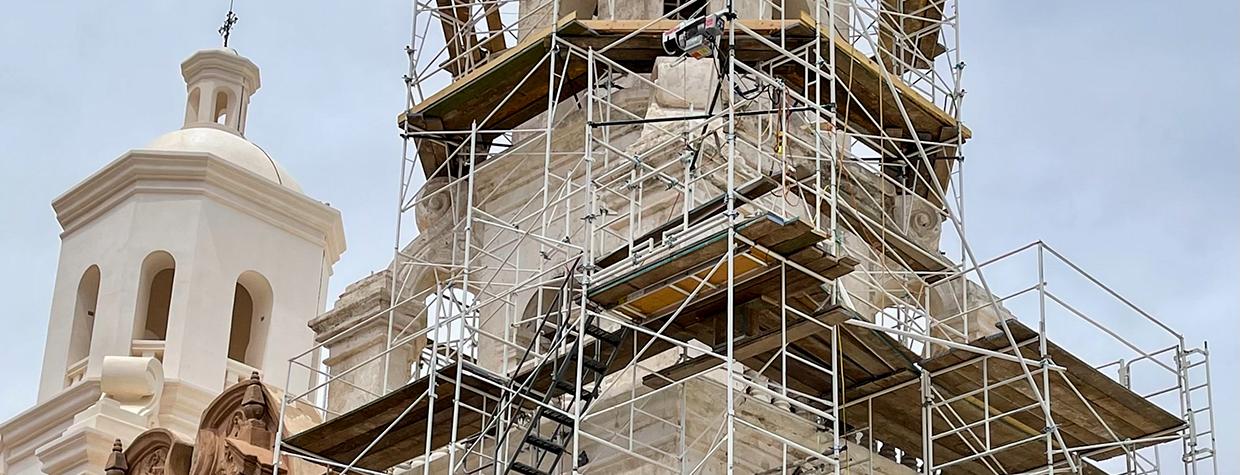Something old is being made new again in the Sonoran Desert southwest of Tucson. The historic unfinished tower at Mission San Xavier del Bac is ready for a new generation of worshippers and visitors, thanks to the completion of a major preservation project that has brought a renewed bolt of brilliance to the “White Dove of the Desert.”
Conservation crews have spent more than a year repairing the gleaming white showpiece — and undoing well-meaning rehabilitation efforts from the first half of the 20th century, which saw workers apply damaging Portland-cement-based plaster to the adobe bricks on the tower’s exterior. Deteriorated brick was repaired, other damage was fixed, and a more traditional, breathable lime-based plaster — one that incorporates cactus juice and is more elastic — was applied throughout.
“We’re kind of doing a conservation that’s not quite so heavy-handed as in the past,” says Miles Green, executive director of Patronato San Xavier, a nonprofit group that’s been directing the mission’s preservation efforts since 1978. “We’re trying to maintain what the original builders did as much as possible … not try to use modern skills to make it perfect.”
The work on the East Tower’s exterior represents the final phase of a two-part project at the 18th century mission, renowned by historians as one of the finest examples of Spanish Colonial architecture in the United States. First, workers had to shore up the aging tower’s foundation and lower walls. Then,
it was on to the plaster.
The long-awaited project was supposed to launch after completion of the West Tower’s renovation in 2008. But preservationists say the recession forced an abrupt halt to their plans. Private donations and a $250,000 grant from the National Fund for Sacred Places are funding the renewed work.
Green says funding woes are not unusual for the East Tower, which was left without a dome when it was “completed” in 1797 because its builders ran out of money. Even now, there are no plans to put a top on the tower. “Absolutely not,” Green says. “The nature of conservation is that you don’t put back what was never there. That would be a no-no.”
With the project’s completion, plans call for the next work to focus on the mission’s elaborate facade. That work is slated to begin in late 2023.
Since its founding, Patronato San Xavier has spent an estimated $14 million to stabilize and preserve the place envisioned by Jesuit missionary Father Eusebio Francisco Kino upon his arrival in 1692 and completed by the Franciscan fathers who followed. Modern-day caretakers got a shock in the 1980s when water-damaged plaster began falling from the mission’s interior vaults, leading the group to focus on exterior preservation to prevent further water damage.
In 1992, Patronato brought in an international team headed by the Solomon R. Guggenheim Museum’s chief conservator, Paul Schwartzbaum, to begin conserving the artwork inside the mission. Four apprentices from the Tohono O’odham village of Wa:k were placed on the team to train as conservators, helping to ensure that the conservation work inside the church would continue.
That work continues today under the watchful eyes and skilled hands of Tim Lewis and Matilde Rubio, the husband-and-wife conservators who’ve been working on the still-active church for nearly three decades. The couple also have enlisted their niece, Susie Moreno, to help in their work for the past five years.
Lewis, 60, a parishioner and one of the apprentices from the Schwartzbaum team, says the work is important and continues to be a labor of love. “As I got more into this work, I realized how important it is to the people as well, not only to myself but to the community,” he says during a break from working inside the building’s west transit. “We’re not really working for ourselves. We’re working for the people who built the church in the first place and the people here today.”
For Moreno, 28, the venerable mission has seemingly always been a part of her life. She attended Mass there weekly, received Holy Communion and went to its school. But she says it wasn’t until she started work there that she felt a deeper connection to the mission. “You’re preserving and taking care of what other people did, all their hard work,” she says. “They put their heart and soul into what they did here. That’s where the specialness of this place comes in for me.”
Lewis says the old mission has an enduring appeal for the young, the old, longtime visitors and those getting their first glimpse. “When people come inside, it’s like, ‘Wow,’ ” he says. “That’s all you hear. It’s like, ‘Wow.’ They can’t believe that you can have this much artistic work inside the church. Especially here in the desert.”
NEAR TUCSON: Mission San Xavier del Bac, 1950 W. San Xavier Road, 520-294-2624, sanxaviermission.org

